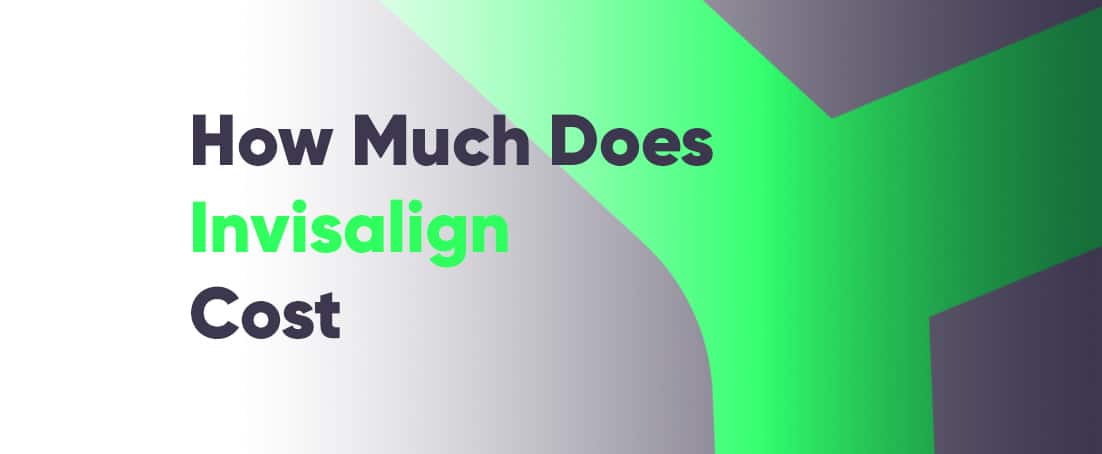As more people get curious about Invisalign in 2024, it’s crucial to know what it costs. Just like the smiles of each individual are unique, Invisalign prices are different for each patient.
“How Much Does Invisalign Cost?” is a question with lots of factors involved. Things like how complicated your case is, where you live, and any extra services you need can all affect the treatment cost. Let’s break it down and find out what you need to know about the cost of Invisalign.
Table of Contents:
Factors Influencing Invisalign Costs
Considering the various factors mentioned below, it’s clear that the cost of treatment with Invisalign can vary. By understanding these factors, you can better categorize your case and get a rough estimate of the expected cost of your Invisalign.
- Complexity of Your Case: Simpler misalignments, such as minor teeth straightening, requires fewer sets of Invisalign aligners, impacting the cost of your orthodontic treatment. But for complex bite issues, expect more aligners and potentially longer treatment, raising the cost.
- Geographical Variations: Cost of Invisalign treatment might differ across regions due to varying practice overhead and living expenses.
- Invisalign Provider’s Expertise & Reputation: Renowned dentists may command higher fees for orthodontic treatment with Invisalign due to their experience and established track record in addressing dental health issues. Consider it an investment in the proven track record of the doctor in crafting beautiful smiles. You can check the review and ratings of the dentist or orthodontist before visiting them for Invisalign consultation.
- Treatment Package Inclusions: Prices of attachments, refinements, and other extras, like retainers, add to the equation. Understanding what’s included in your Invisalign plan and any potential additional costs upfront ensures budgeting clarity.
By understanding these factors, you can gain a clearer picture of your personalized Invisalign investment and make informed decisions towards your dream smile.
Orthodontic treatment with Invisalign and other clear aligner brands may be partially covered by insurance. Explore our guide on “Does Dental Insurance Cover Aligners?” for valuable insights.
Average Treatment With Invisalign Cost
The average cost of Invisalign treatment varies based on several factors, including the complexity of the case and where you live. For adults, it typically falls between $2,800 and $9,000, and for teens, it’s usually between $3,000 and $6,000. This cost covers impression kits, aligners, and other tools needed for treatment.
Insurance may help with some of the expenses, usually covering 25% to 50% of the cost of Invisalign. Many dental insurance plans treat Invisalign like traditional braces, offering family discounts. If your insurance company doesn’t cover Invisalign treatment expenses, you can use your HSA or FSA to pay for it. Several orthodontic offices also offer easy monthly payment plans and promotional discounts on total treatment cost with Invisalign.
As for how long to wear aligners, it’s recommended to keep them on for at least 22 hours a day. Orthodontic treatment duration with Invisalign can vary, lasting anywhere from 3 to 36 months, depending on your dental status and the severity of your teeth issues.
Invisalign Cost for Common Dental Issues
The cost of treatment with Invisalign can vary significantly depending on the nature and complexity of dental issues. Factors such as the severity of the case, the number of aligner sets required, and the treatment duration all play a crucial role in determining the overall cost.
Understanding these factors is essential for individuals considering treatment with Invisalign, as it provides insight into the financial investment required to address their specific dental concerns.
Mild to moderate misalignments
For mild to moderate teeth misalignments, such as front teeth gaps or slightly crooked teeth, the cost of Invisalign typically ranges from $1,500 to $4,500. This cost variation is influenced by factors such as the number of aligner trays needed for the specific orthodontic case.
Severe malocclusions
For severe malocclusions, such as bite issues and teeth crowding, the cost for orthodontic treatment with Invisalign typically ranges from $3,000 to $8,000. This variation in cost is due to the potentially higher number of aligner sets needed. Additionally, more severe dental cases may require longer treatment times and additional orthodonticprocedures, such as dental implants, contributing to the overall cost of Invisalign.
Specific tooth alignment issues
For specific tooth alignment issues, the cost of complete orthodontic treatment with Invisalign is typically between $1,800 and $10,000. This wide range reflects the variability in costs, influenced by factors such as the severity of the issue, the number of aligners required, and the duration of treatment.
More complex dental cases may necessitate a higher number of Invisalign aligners and longer treatment duration, resulting in a higher overall cost of Invisalign.
Invisalign Cost for Different Age Groups
While age itself doesn’t directly impact the technical aspects of orthodontic treatment with Invisalign, it can influence the treatment plan and, consequently, the cost. Let’s dive into how different age groups might see variations in their Invisalign journey:
Adults
For adults, orthodontic treatment plans with Invisalign and associated costs can vary significantly. From simple misalignments to complex bite issues, expect a wide spectrum of costs tailored to individual needs. Additional consultations may be necessary for those with previous dental work, potentially affecting the overall cost.
Treatment costs typically range from $3,000 to $9,000, with more severe orthodontic cases leaning toward the higher end. On average, adults can expect to pay around $4,000 to $7,500 for treatment with Invisalign.
Teenagers
For teenagers, variations in treatment plans and associated costs with Invisalign are influenced by several factors. Early intervention can optimize teeth alignment, potentially reducing the number of aligners needed and keeping the cost lower.
Additionally, teenagers are still growing, necessitating potential adjustments to treatment plans, which can impact overall costs compared to adults with settled jaw development. On average, the cost for teens ranges from $3,000 to $8,000, with most cases falling between $5,000 and $5,500.
Children (limited cases)
Many parents choose Invisalign over braces for their children due to its discreetness, better oral hygiene, and shorter treatment times. For children, orthodontic treatment plans with Invisalign and associated costs may vary. Simpler dental corrections often mean shorter treatment times and potentially lower cost than adults and teenagers. The cost can vary widely based on the specific condition and the length of orthodontic treatment.
Traditional Braces vs. Invisalign Costs
Invisalign and braces are not only compared due to their efficacy but also due to their cost. Let’s compare Invisalign vs braces cost to help you weigh your financial options:
Initial Cost:
- Traditional Braces: Ranging from $4,000 to $10,000.
- Invisalign: Ranging from $3,000 to $8,000.
Hidden Costs:
- Traditional Braces: Potential emergency appointments for broken brackets, adjustments of the braces, and longer treatment times can lead to additional costs.
- Invisalign: Replacement aligners or lost retainers incur extra expenses.
Long-Term Savings:
- Traditional Braces: May require permanent retainers, adding to long-term costs.
- Invisalign: Removable and often requires only short-term retainer wear, potentially saving money in the long run.
Your specific case and provider’s expertise heavily influence the cost of orthodontic treatment with braces or Invisalign. By understanding the upfront cost, potential hidden expenses, and long-term savings associated with each option, you can make an informed decision that aligns with your budget and smile goals.
Additional Costs and Considerations
While understanding the baseline Invisalign cost is crucial, hidden expenses can lurk around the corner. Here are some additional costs to factor in for a clear financial picture:
Before Treatment Begins:
- Initial Consultation Fees: Consultations often come with fees, ranging from $50 to $200 depending on the provider.
- X-rays and Diagnostic Tests: Panoramic X-rays, 3D scans, or other imaging modalities incur additional costs, typically between $100 and $300.
During Treatment:
- Attachments: Tiny bumps bonded to teeth for better aligner grip might be needed in some cases, adding $50-$100 per attachment.
- Refinements: Minor adjustments to your treatment plan due to unforeseen tooth movements can lead to additional aligner sets and potentially higher costs.
After Treatment:
- Retainers: Essential for maintaining your straightened teeth, they usually range from $150 to $500, depending on the type and material.
To avoid surprises, always request a detailed treatment plan outlining all costs involved, including:
- Number of aligner sets
- Any potential attachments or refinements
- X-ray and diagnostic test fees
- Retainer costs
Remember: Costs can vary depending on your provider, location, and case complexity. Don’t hesitate to ask questions and compare different practices to find one that offers clear pricing and aligns with your budget.
Aligners Cost-Benefit Analysis
Don’t let the initial price tag deter you from exploring the transformative power of Invisalign. A well-informed cost-benefit analysis can empower you to make the decision that aligns perfectly with your smile goals and budget.
Invisalign isn’t just about aesthetics; it’s an investment in your long-term oral health. Straightened teeth are easier to clean, reducing the risk of cavities, gum disease, and future dental expenses. Additionally, the confidence boost from a beautiful smile can positively impact your personal and professional life.
If budget is a major concern, explore cheaper alternatives like traditional braces or at-home aligner options. Our guide on Cheaper Alternatives Than Braces can help you navigate these options.
Remember, the best option depends on your unique needs and priorities. Weigh the financial investment against the long-term benefits of improved oral health and confidence. Consider consulting with multiple providers to compare treatment plans and costs for Invisalign.
Affordable Invisalign Alternatives
While Invisalign shines brightly in the orthodontic world, it’s not the only path to a straighter, more confident smile. If Invisalign cost doesn’t align with your budget, treatment with at home clear aligners can be equally effective in addressing many common orthodontic issues, often at a lower price point.
These alternatives utilize similar aligner technology, offering discreetness and comfort, making them attractive options for budget-conscious individuals.
Some popular alternatives include Byte, AlignerCo, and Candid. Byte invisible aligners boast fast and convenient at-home treatment with dentist oversight, starting at around $1,999. AlignerCo aligners shine with flexible payment plans starting at $995. Unlike “one-size-fits-all” approaches, AlignerCo creates individually tailored treatment plans based on your unique smile goals and needs,
Candid’s clinically proven Candid Pro aligners, with in-person checkups for peace of mind, begin around $3,300. It’s important to research and compare options to find the one that best suits your needs and budget. Consult with a dental professional to discuss your specific case and explore the most suitable and affordable clear aligners option for your smile journey.
Final Words
The best advantage of Invisalign clear aligners is that they offer a discreet and effective path to a beautiful smile. However, determining their cost can be complex. Remember, factors like case severity, location, and provider expertise influence the final price. Explore affordable clear aligners and prioritize transparent communication with providers to understand all associated costs.
Ultimately, investing in your oral health through orthodontic treatment can provide long-term benefits for your smile and confidence.

